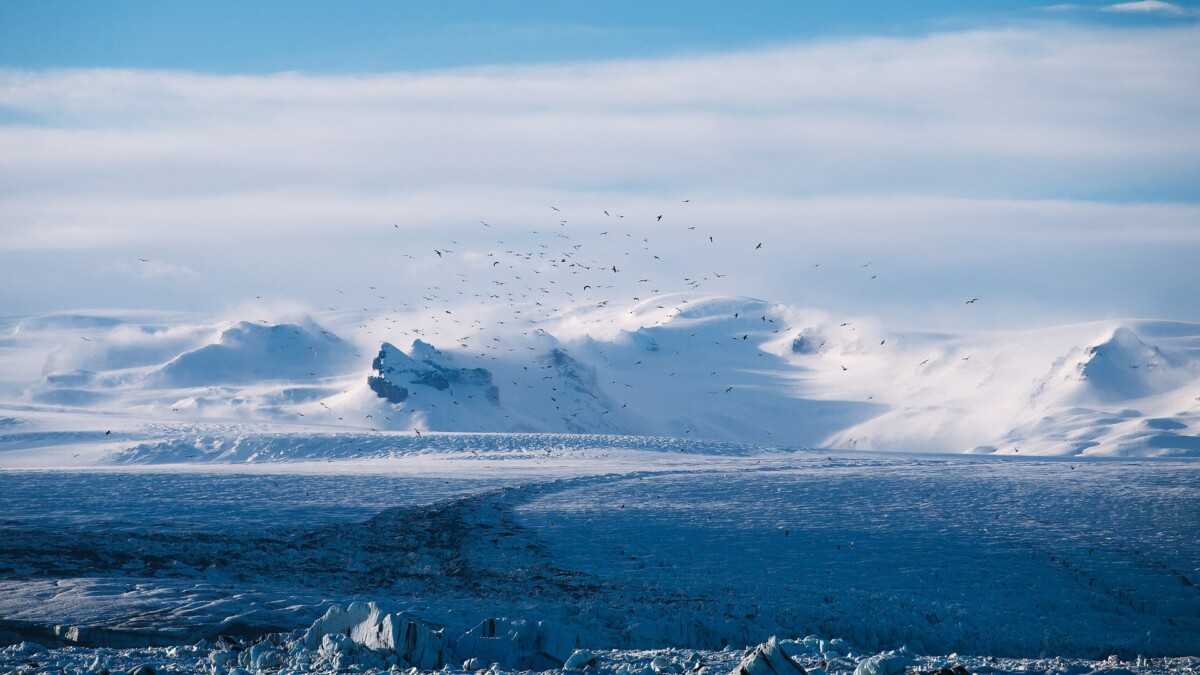And melting icebergs from Antarctica seem to play a key role.
We have known for some time that the orbit of the earth around the sun determines the moment when ice ages occur. If the distance between the earth and the sun is greater, then an ice age will most likely start, because then less solar radiation reaches the earth’s surface. Until now, however, it was unclear how small variations in solar energy could cause such dramatic changes in Earth’s climate. But a new study now reveals exactly how this works. “It was already clear how the earth emerged from an ice age,” says earth scientist Martin Ziegler, who works at the University of Utrecht. “Our results now finally give us clues about how an ice age is set in motion.”
Missing link
In the study, the researchers have, as it were, the ‘missing link’ found in the process leading to an ice age. “The cold climate conditions of an ice age are related to a reduced atmospheric CO2 concentration,” explains Ziegler Scientias.nl from. “This missing CO2 is stored in the deep sea, made possible by a changing ocean circulation. Until now, however, it was unclear what process caused this shift in ocean circulation and what exactly spurred that extra carbon storage in the ocean. ”
Icebergs
But now the researchers have found an explanation for this. In their study, the researchers explain that, when Earth’s orbit around the sun meets the right conditions, icebergs begin to melt further and further away from Antarctica. “In the study, we show that at the beginning of an ice age, the trajectory of icebergs in the Southern Ocean from Antarctica changes,” said Ziegler. “They are melting much further north. This melting site is important because the sweeter water has a lower density than salty seawater and thus affects global circulation patterns. ” It means that huge amounts of fresh water flow from the Southern Ocean to the Atlantic Ocean. As the Southern Ocean becomes saltier and the North Atlantic Ocean sweeter, it causes drastic changes in the large-scale circulation patterns that characterize the oceans. This also removes CO2 from the atmosphere, resulting in a reduction in the greenhouse effect. And so an ice age arises.
Ice cores
These findings arise from the analysis of samples collected by the International Ocean Discovery Program (IODP). “The study was possible because very long (~ 250 m) cores were drilled for the first time in the western Indian Ocean in 2016,” says researcher Jeroen van der Lubbe, affiliated with the University of Amsterdam. Scientias.nl. “An international team of researchers worked for months on board a drillship collecting sediment cores and mapping their properties. On behalf of the Netherlands and the VU University Amsterdam I took part in the expedition (361 ‘Southern African Climate’), in which the core for this study was taken. ” The researchers thus come to an interesting discovery. “The on-site ocean temperatures we studied (south of South Africa) are far too warm these days, which means that icebergs are no longer able to survive to that location,” says Ziegler. “When I studied the sediments deposited at the beginning of the last Ice Age, I found a lot of iceberg-derived material here. I was very surprised. This discovery was the starting point of this study and eventually led to a new theory about the origin of ice ages. ”
Climatic conditions
The scientists then used a variety of techniques to reconstruct past climatic conditions. One of these was to identify small fragments of Antarctic rock deposited in the open sea by melting icebergs. These deposits appear to have consistently anticipated changes in deep ocean circulation. The researchers concluded this from the chemistry of small deep-sea fossils called foraminifera. In addition, the team also used new climate model simulations to test their hypothesis, finding that massive amounts of fresh water could be moved through the icebergs.
Key
All in all, it means that melting icebergs from Antarctica played a key role in the formation of ice ages. The icebergs trigger a series of chain reactions that plunge the Earth into a prolonged period of cold temperatures. “The melting of icebergs is a trigger that put the circulation into a certain mode at the beginning of an ice age, allowing the deep sea to store more carbon than during the interglacial,” summarizes Ziegler. “It has been known for some time that the Southern Ocean plays an important role in the transition from an ice age to a warm interglacial period (our current state). Our study now shows that the Southern Ocean also plays a key role at the beginning of an ice age. This link has not been considered before and the data to prove this link did not exist. So it is a surprising discovery that gives us a new perspective on the origin of ice ages. ”
“Our study shows that the Southern Ocean plays an important key role at the beginning of an ice age”
Disturbance
The described process has regularly caused ice ages for the past 1 million years. And that should happen again in the future. “The process described would probably have heralded the beginning of a new ice age in a few thousand years,” said Ziegler. At the moment, the Earth is still in an interglacial period, in which it is warmer. But that should change ‘soon’. However, the question is whether that will actually happen. The researchers point to a disruption of the natural rhythm of the Ice Age cycle. The perpetrator? Global warming as a result of CO2 emissions from humans.
Emissions
The researchers argue that today’s high CO2 concentrations make the formation of a new ice age impossible, even with a ‘favorable’ Earth orbit. “By burning fossil carbon, humans have completely disrupted the natural ice age cycle,” explains Ziegler when asked. “The atmospheric CO2 content is now higher than we have seen in the last 3 million years. This leads to sustained global warming. However, the melting of ice sheets and the addition of fresh water will also affect global ocean circulation in the future. The consequences of this are not yet fully understood, but our study once again shows that the ocean-atmosphere-climate system is sensitive to even relatively small triggers. So we will have to monitor all changes closely. ”
According to co-author Ian Hall, the research results can be used to understand how our climate will respond to human-induced climate change in the future. “We are already seeing the Antarctic continent losing mass and more and more icebergs floating in the Antarctic Sea, as a result of global warming associated with current human greenhouse gas emissions,” Hall said. “Our study thus emphasizes the importance of understanding iceberg trajectories and melting patterns. These contribute to the development of reliable predictions of their future impact on the ocean circulation and the climate. ”
–
–
Keep amazed ✨
Receive the most beautiful space photos and interesting popular science articles every Friday. Get the free Scientias Magazine together with 50,000 others.


